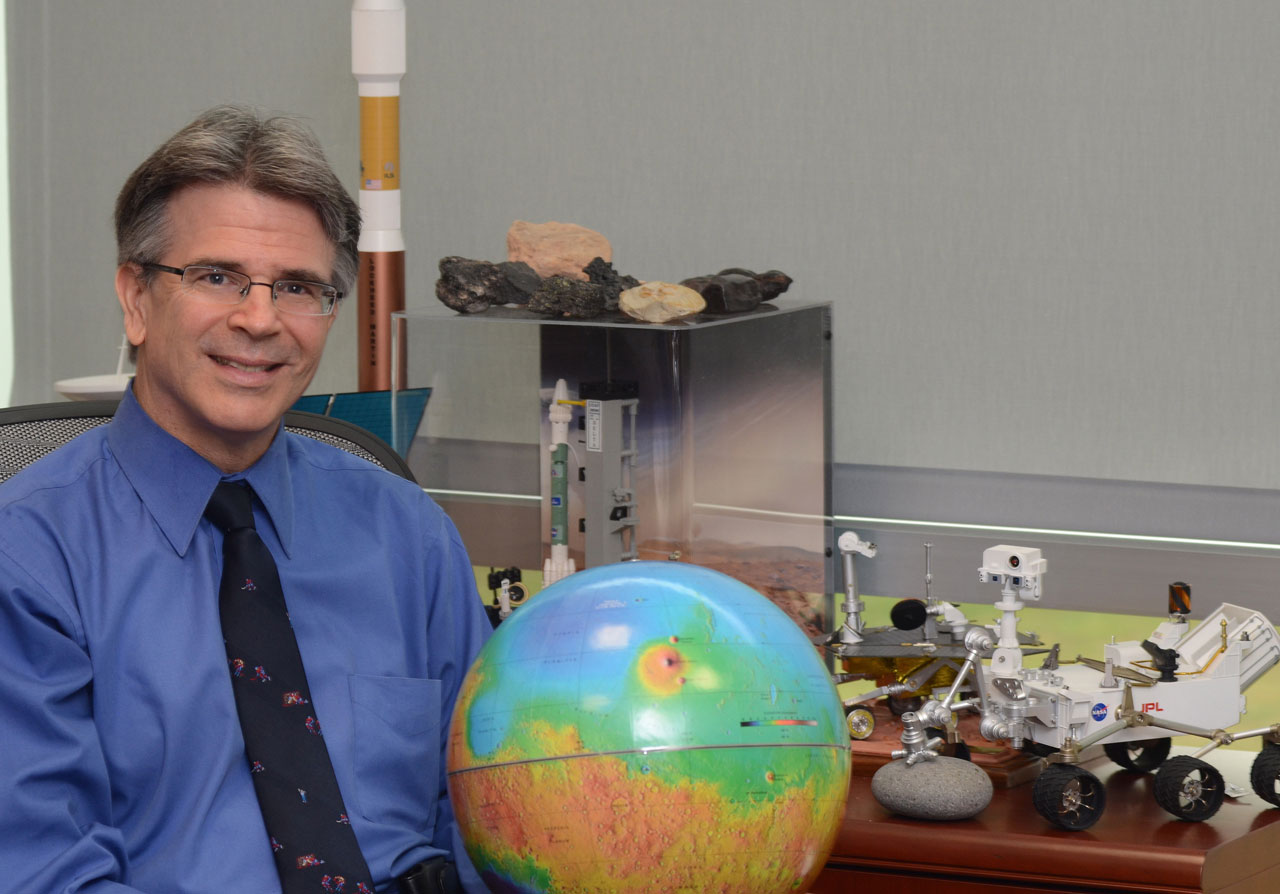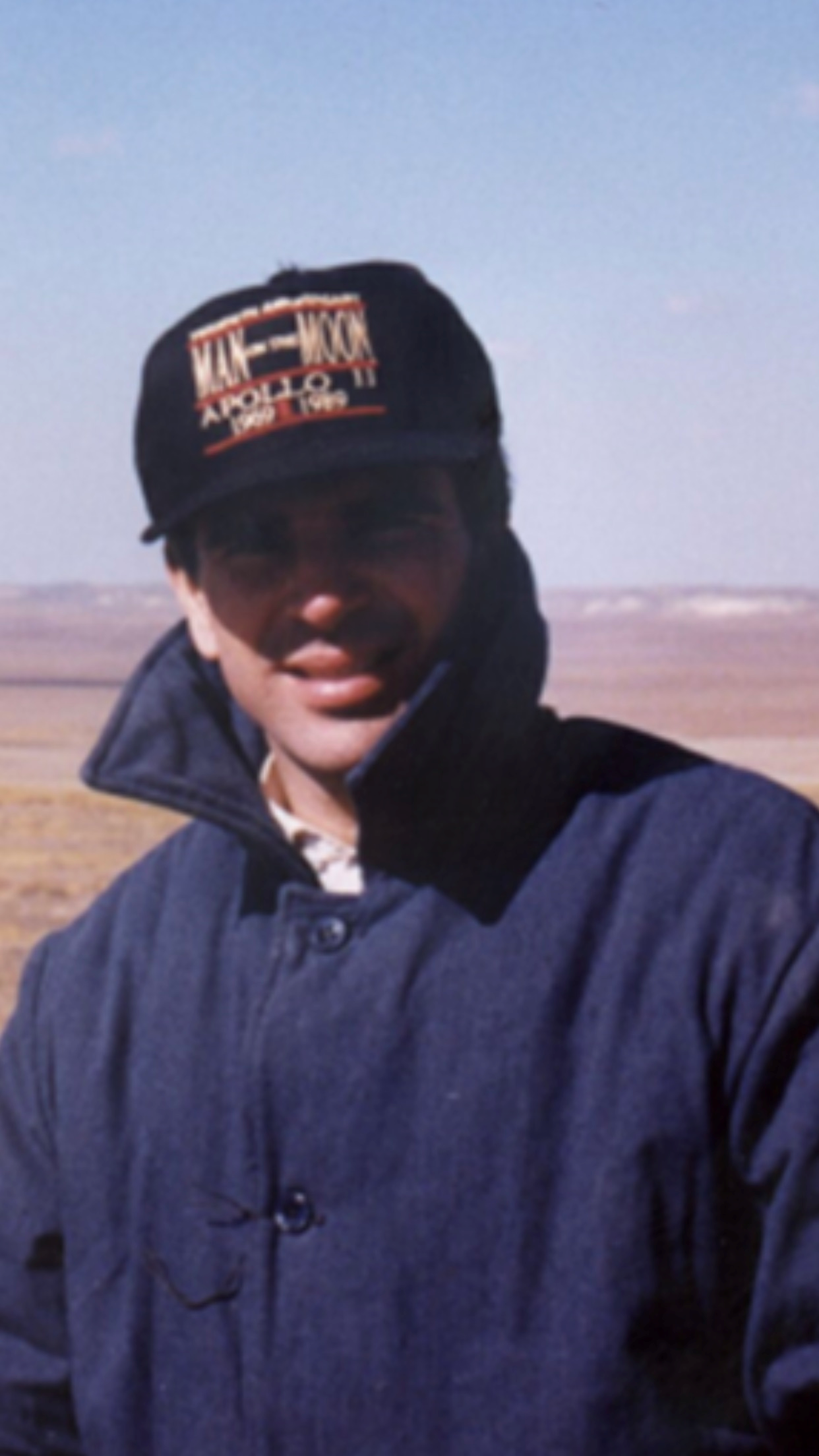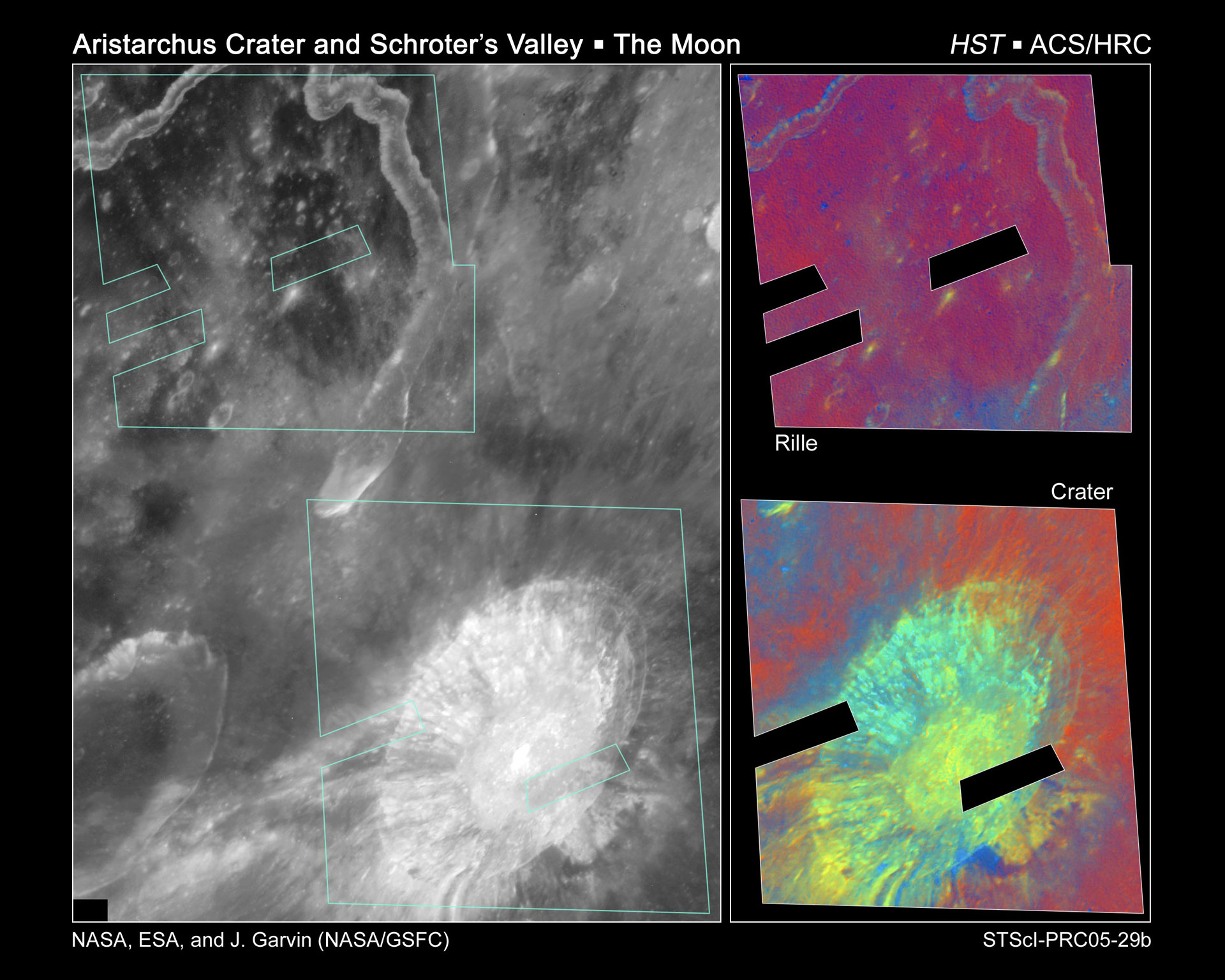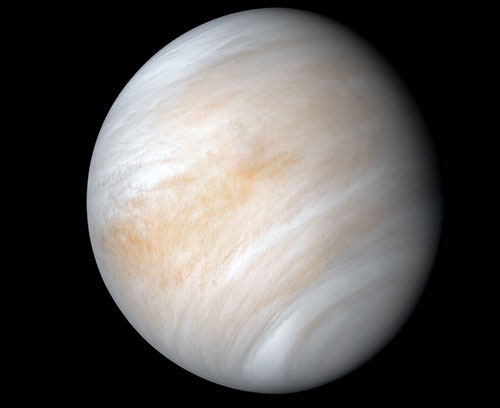
James “Jim” Brian Garvin
Chief Scientist - NASA Goddard Space Flight Center
Staples High School, Westport CT
Brown University
Applied Math/Computer Sciences with Geosciences (undergrad), PhD in Geological Sciences
Stanford University
Masters of Science in Computer Sciences
I was hooked "at birth" according to my mother, who told me I used to ask her about the Moon. As a toddler I collected rocks and insects, and from my earliest days I always wanted to be a scientist. Living abroad as an elementary school-age kid, I witnessed the magical deserts of the Middle East as well as the exotic landscapes of Australia, New Zealand and the Fiji islands. I will never forget seeing the volcanoes of the North Island of New Zealand and marveling at their landscapes. While in junior high, I went on a crusade to discover new aquatic insects in the ponds of Connecticut and loved exploring the accessible natural world via rocks, minerals, insects and coniferous trees. During the Apollo era, I was mesmerized by the realities of the Moon and the mystique of Mars and Venus. I can never remember a time when science and its connection to space was not part of my life.
It was what I always wanted to do, but finding a pathway to end up where I am now, a veteran of NASA for nearly 36 years (plus five years in graduate school working on NASA missions) was an adventure. I was inspired by chemistry and physics in high-school and fortunately I ended up at Brown University as an undergraduate, where progressive opportunities for exploring multi-disciplinary scientific (and history of science) topics were encouraged. I managed to take several exploratory classes taught by inspiring professors who introduced me to space exploration, a new era in geology, computer modelling of the natural world, and other topics, right as Project Viking was landing on Mars. I was able to secure an internship via Viking, and while at Stanford (for a masters degree) I connected with Professor Tim Mutch, who had taught me about the geology of Mars while I was at Brown. He suggested I come back to Brown to study under him and Jim Head, to work on connecting the local landscapes of Mars to those on Venus observed by the Soviet Union. This was beyond captivating.
As I finished my doctorate, I travelled to the AIr and Space Museum where I met Noel Hinners, then center director at NASA's Goddard Space Flight Center. He suggested that I consider GSFC, given their large science cadre and his own personal interests in Mars and Venus. Thus, I came to GSFC armed with the idea of transforming how we explore those two planets. Within months, I met some of the enabling engineers of NASA who allowed me the freedom to dare to consider how to measure what was previously unmeasurable. That gave me my start in such areas as spaceborne laser altimetry for Earth and Mars (and the Moon), Hubble observations of the Moon in ultraviolet, analysis of sedimentary structures on Venus from Soviet lander images, and exploration pathways that connect Earth and the planets. I cannot imagine anything more invigorating and the people I have been privileged to work with, from Sally Ride to Noel Hinners to present colleagues such as Paul Mahaffy, Stephanie Getty, Giada Arney, Justin Jones and so many more — it makes my ongoing life's work a joy.
As chief scientist for NASA's Goddard Space Flight Center, my activities usually involve serving as a catalyst for the incredible cadre of scientists there, and developing connections to advance new measurement approaches (that is, instruments) for missions of profound discovery across all the science themes we pursue at NASA. I believe in encouraging the passion for scientific innovation at all scales, and in promoting measurement of the universe in 3D, from nanometers to meters to kilometers. I helped develop NASA's Science Innovation Fund, and ideas for science missions that connect different disciplines across the solar system to the larger universe.
Presently, I am serving as principal investigator for the DAVINCI+ mission concept for the planet Venus, a recently selected finalist (in Feb. 2020) for the next one or two missions to objects in the solar system to launch by the mid 2020s. As the primary investigator (PI), working with two amazing Deputy PIs, and with our incredible engineering and project management team, my role is to direct the overall mission so it delivers breathtaking science within budget and on schedule. I have worked my entire 36-year NASA career for this opportunity, and it is my lifelong dream to be working on this potentially historic mission with so many talented women and men, many of whom are the future leaders of NASA.
I also support NASA's Mars Exploration program via science roles on flight missions such as Curiosity and Mars InSight, and I have served as an advisor to NASA associate administrators and Mars program directors on strategies for Mars exploration, which led to the flight of Curiosity, the Mars Reconaissance Orbiter, and the Mars 2020 Rover Perseverance. Finally, I have always been fascinated and captivated by small, oceanic islands and their impressive responsiveness to Earth system "forcings," and I am continuing to monitor and model Earth's newest lands in the Kingdom of Tonga.
To be a scientist, in my view, requires one to unleash your passions and curiosity about questions where results could be transformational. Tenacity and diligence always pay off in science, and communicating the results of scientific adventures of any sort is always critical. Scientific work may at times seem esoteric and complex, but there is always a great story about the women and men doing the challenging work that connects it to everyone, even those not interested in science. Never wait to wonder!
For me, my perhaps overly large breadth of interests in scientific topics that span many disciplines has been a challenge, as keeping focus to deliver scientific results via research papers, presentations and special datasets requires organization and time management. I have always struggled to balance my insatiable curiosity for the wide array of things I have been so fortunate to work on, with the realities of time available, and milestone deliverables. Thanks to some amazing colleagues and family members who have helped me organize and focus my energies toward critical deliverables, I have been successful (or so I hope I have been).
Too many superb people to list here, but there are a few key players who always gave me the hope and support for moving forward. First, my parents were always encouraging, and my mother allowed me to bring a never-ending stream of rocks, bugs, fungi and other exotic items into our residences, with never a question. When I was a 7th grader, I had a science teacher (Mr. Janeway) who cultivated my passions for the natural sciences quietly, but with encouragement that I will never forget — he even allowed me to map the tree cover in the woods around our school for weeks, during school hours. While at Brown University, both Tim Mutch (now deceased) and Jim Head provided me with the opportunities to become a scientist and explore space. Richard Grieve (then a professor at Brown) encouraged me to become enraptured by impact cratering and to link this process from Earth to Mars, the Moon, and Venus. Sally Ride showed me what brilliant leadership and wisdom can do, even after disasters such as Challenger. Engineers such as Jack Bufton and Jim Abshire allowed my dreams to become realities via spaceborne laser instruments that mapped Mars, the Moon and now Earth. Colleagues such as Bryan Blair and Justin Jones showed me how engineering brilliance delivers unimaginable science. Chris Scolese and Ed Weiler allowed me to push the envelope and enable new classes of planetary exploration for our community with their guidance and leadership. Our entire DAVINCI+ team gives me hope and inspiration every day. We named DAVINCI+ for Leonardo da Vinci, who has always inspired me given his breadth and quality of innovative contributions to science, art and "visioneering," centuries ahead of his time. Finally, my children and wife have always given me the special inspiration that allows me to keep going amidst life's many challenges, and the hope to dare to explore. To all of these people I am most grateful.
In 36 years at NASA (with hopefully more than a dozen more to come), there are many. Our work promoting the first geodetic-quality laser altimeters in space that culminated in the flight of the Shuttle Laser Altimeter (SLA) on STS-72 (Endeavour) in January 1996 was very special to me.It brought together the "can-do" spirit of masterful engineering with the power of science-guided human spaceflight on the Space Shuttle, and its first "landfall" was the summit of Mauna Kea (Hawaii) where I conducted fieldwork as a graduate student. SLA and the Mars Orbiter Laser Altimeter (MOLA) investigation that followed in 1997 (via Mars Global Surveyor) were lifelong dreams for me that allowed me to experience the connectivity from idea to development, to flight, to new science. What an exhilarating process!
While I was NASA's first chief scientist for Mars Exploration, I was privileged to work with the amazing people who flew a series of Mars missions that constantly dazzled me on the basis of their far-beyond imaginable performance, including the twin Spirit and Opportunity rovers, the Mars Reconnaissance Orbiter (MRO), and the Mars Science Laboratory Curiosity rover. Working with these missions and the incredible women and men who made them possible was beyond words.
Most recently, studying the emergence of a new volcanic island in Tonga (Hunga Tonga Hunga Ha'apai) as a "new Surtsey" in the beautiful southwest Pacific has been captivating, given that we have been able to engage students via the Sea Education Association programs to visit this newly-formed island to help us understand its evolution. Finally, my current work as PI on the DAVINCI+ mission concept to Venus is not only engaging, but it is the thrill of a lifetime as I witness the never-ending brilliance and hard-work of our team as we attempt to bring the U.S. back to Venus and its massive atmosphere.
Well, I am probably too boring for words, but here are a few tidbits. First, I have always loved ice hockey and managed to actually play hockey as a kid and in high school (as a goalie). Even when a slapshot nearly tore my ear off in an early-morning game, I loved every minute of it. I am passionate about certain music, which before hockey games or other big events gives me a lift — from YES to U2 and REM, and back to Bruce Cockburn, this music has carried me. I am waiting for U2's The Edge to play an instrumental guitar piece about exploring Venus someday.
I adore the great coniferous forests and trees of our planet, and I am a tree empath (and tree-talker), who can barely contain my excitement when I witness such amazing living things. I long for a chance to spend quality time in the Ancient Bristecone National Forest to feel the voices that have echoed over time as these trees have stood tall. I have always loved to read, and I enjoy mysteries and science fiction — Frank Herbert's Dune has always been my favorite.
Perhaps my hobbies today are too simple, as they mostly consist of taking "woods walks" with our family dog Glenda, and looking for exotic fungi to photograph. I have witnessed many evocative places on this Earth, but to me visiting Surtsey (an island off the coast of Iceland) is one of the most momentous. Working in the field at Zhamanshin impact structure in Kazakhstan in the late 1980s with Soviet scientists was compelling as well, seeing what I still believe to this day to be the largest recent NEO impact event in Earth history.

My personal stories are not that interesting, but I do have a few. When I was around 13 a school bully used to pick on me (and many others). So one day while being bullied, I showed this unruly person a giant water bug in a jar that I had taken to "show and tell" in science class. He scoffed at the 2-inch-long "bug" and I asked him if he was brave enough to hold it. He told me he was braver than I, and insisted I put it in his hand. I will never forget his look of horror and pain when the large water bug bit him mercilessly and he ran off. He never bothered me again. When I was 9 or 10, my family traveled to upper Egypt to see antiquity in action (as it was described to me). I will never forget traveling to King Tut's tomb with a handful of people before they moved most of the incredible artifacts, and literally seeing walls of gold and other art-forms as they were in the tomb.
I will never forget when the MOLA laser altimeter achieved "first light" at Mars in fall of 1997, and we saw the Martian surface at human scales, in 3D, for the first time. Lastly, how can I ever forget the births of my children, who to this day inspire me with their brilliance? And for fun, I must admit that I am a huge fan of drones as a tool for seeing new perspectives, but am incapable of successfully operating these incredible devices — my family refuses to let me crash another drone!
There are so many!!!! Recently, the Lunar Reconnaissance Orbiter (on which I was the first program scientist, and the person at NASA HQ who ran the competition for its scientific payload) acquired evocative images at what we call "high sun" of pristine, simple impact craters (I call them "Simple Visions", as in the song by the Strawbs). One of these in particular has always captured my attention because it speaks volumes about the cratering process. But, perhaps for me, the 2005 Hubble Space Telescope image of lunar crater Aristarchus that we acquired in support of human exploration is one of my favorites. It links the capabilities of an astrophysical icon to the return of people to the Moon, and to a special example of what the Moon can teach us.

A proposed mission called DAVINCI+ could one day fly the first U.S. spacecraft since 1978 to study the atmosphere of Venus. On Feb. 13, NASA announced that DAVINCI+, named after the visionary Renaissance artist and scientist Leonardo da Vinci, is one of four teams selected to develop concept studies for new missions in this decade to various intriguing destinations in the solar system. Out of these four finalists, NASA will select one or two missions for flight by summer 2021.
Planetary science is a global profession.


